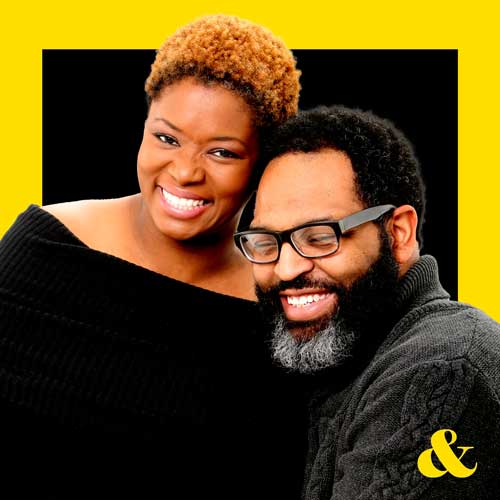When we started this podcast, we just used the website that came with our podcast host. It was fine, but it didn’t have a lot of the features that I wanted and that I knew were important. I have built many websites, and I know that having a podcast website isn’t just about having an online presence—it’s a powerful tool to engage your audience, convert casual listeners into dedicated fans, and grow your mailing list. You don’t have to have a custom site when you start, if you don’t have the resources to have one built or the know how to do it yourself. If you decide to build a website for your podcast, here are some ways to make sure your website does exactly what you need it to do.
First Impressions Matter
Professional Design and Easy Navigation
After the podcast player apps, your website is the next place current and potential fans will go to learn more about you and your show. Make sure it looks professional and is easy to navigate. A clean design will create a sense of trust and make users more likely to stick around. If your website is confusing, visitors will leave and likely not return to give you a second look.
Mobile Friendly and Fast Loading
Nobody likes to wait for a website to load. The faster it loads, the longer your visitors will stay, and the more pages they will likely look at. It is very important to make sure your website works loads quickly. Slow load times can lead to higher bounce rates and missed opportunities to convert visitors. Most people discover and listen to podcasts on their phones, so your site needs to be mobile-friendly as well, especially if there are links to your website on your podcast page and in your show notes on listening apps.
Consistent Branding Is Key
We had photos that our son took of us while he was practicing his photography (he is a photographer now), so we just built our branding around those. Our podcast thumbnail is one of those photos and our podcast name, very simple. From that thumbnail, we made everything else match on the website so that our audience got familiar with our branding. Your podcast logo, colors, and fonts should be consistent across your website and on your podcast app pages, as much as that can be customized. This helps establish a recognizable brand identity. If you can, make sure your podcast’s name, tagline, and mission are prominently displayed on the homepage, or at least on your about page, so visitors immediately understand what your show is about.
Related: Create a Podcast That Your Audience Can’t Get Enough Of
Show Off Your Best Work
Add a Podcast Player on Your Homepage
The goal of your podcast is to have people listen to it. That is the number one objective. Make it easy for visitors to listen to your latest or most popular episodes directly on your homepage. Embedding a podcast player above the fold (before the user has to scroll down) allows visitors to engage with your content right away. Services like Spotify, Apple Podcasts, and many others offer embeddable players that make it easy to add your episodes. We have a player embedded from podcast players, and from our host so that visitors have multiple opportunities to listen to the show.
Choose Fan Favorites to Showcase
Do you know what your most popular episode is? We looked at our numbers and polled our listeners to find out. Then we put a player at the top that featured that episode. Keep in mind that not all listeners will want to scroll through an every episode you have to find one to listen to. Make it easy for them to find episodes that are likely to make them fans. You can feature a “Start Here” section or page with essential episodes for new listeners. You can organize episodes by category or theme which helps visitors get find episodes they can relate to and get hooked on your podcast quickly.
Make the Most of Show Notes and Transcripts
Did you know that Apple Podcasts has transcripts of your shows as soon as you upload them? Including detailed show notes and transcripts for each episode on your website helps with SEO and accessibility. I have not seen where our Chat & Bother transcripts are discoverable on Google because of Apple Podcast transcripts, but there are people who swear this helps SEO. I suggest that you take matters into your own hands and have your show transcript on your own website. Copy it from the Apple Podcast app if you can and paste it on your website! People who may not have time to listen can quickly skim through the content, while those who are hard of hearing can still engage with your material. Take matters into your own hands, and add your transcripts to your own website, so that you can be sure that the transcript is searchable on your website as well as Google and other search engines.
Related: How to Prepare for Your Podcast to Go Viral Like Shannon Sharpe
Tell Visitors What You Want Them To Do
Ask Visitors to Subscribe
We want our listeners to join our mailing list. It is a great way for them to keep up with what is going on with us besides our new episodes. One of the main goals of your podcast website should be to convert listeners into email subscribers too. Keep your visitors from asking themselves, “what do I do now?” once they arrive at your home page. Make it easy for them to join your email list by placing prominent, clear CTAs (calls to action) in a pop up on your homepage, episode pages, and in the footer. Use phrases like “Never Miss an Episode” or “Join Our Mailing List for Exclusive Content” to make visitors excited to get to know more about you and your podcast.
Give Your Audience Several Ways to Join
We have a pop up form as soon as a new visitor comes to the website, but we don’t rely on that one signup form. Visitors can opt-in on the sidebar, in pop-up forms, at the end of blog posts, or on a dedicated landing page from our list provider. Make sure these forms are quick and easy to fill out. If all you need right now is their email address, that’s fine!
Offer Incentives
To encourage people to join your mailing list, consider offering exclusive content like behind the scenes videos. You can also offer bonus episodes, early access to shows, or a downloadable guide or ebook that is relevant to your podcast’s subject matter. Incentives give listeners a reason to subscribe beyond notifications of new episodes.
Related: How to Market Your Podcast WITHOUT Social Media
Share Why Should They Should Subscribe
Testimonials and Reviews
⭐️⭐️⭐️⭐️⭐️
“I love listening to Don and Eva. They are funny and it’s like a weekly podcast with my friends. Every time I listen I feel like we are all in the same room talking. I’m just waiting my turn before I give my opinion.”
We have a testimonial and star rating right on our sign up pop up, along with our award from the Essence Film Festival Podcast Competition. This tells visitors that its not just us that believes our show is great – others believe it too! Showcasing listener testimonials or reviews from platforms like Apple Podcasts can help build credibility for our show. How often do you choose a product or restaurant because of ratings and testimonials? I rely on them heavily. A section featuring your podcast’s ratings and reviews acts as social proof, encouraging new visitors to listen to your show.
Include Media Mentions and Celebrity Guests and Collaborators
Has your podcast has been featured in the media? Have you collaborated with well-known or celebrity guests? Highlight this on your website. Include badges or logos from publications that have mentioned your show—this boosts your podcast’s authority and appeal.
Get That Engagement Going
While people don’t spend a ton of time in the comments on websites anymore, you can encourage interaction on social media. Include your social media links where your fans can follow and engage with you. Create timely stories on Instagram and Facebook that lead fans to your podcast or your website. If you are active on Twitter and Instagram, integrate your Twitter or Instagram feed directly on the site to show that you’re active and accessible. If you do not update those platforms frequently, don’t include it on your site.
Include a Blog
Extend the Conversation
A blog is a great way to improve SEO and gives you an opportunity to add on to what you have talked about on the show. This gives listeners another reason to visit your website regularly. It also gives you another opportunity to link to your other shows that may be relevant to the topic you are blogging about.
Showcase Expertise
Don and I are business strategists. The blog on Chat and Bother helps us showcase that expertise by helping others start their own podcasts. So many people ask us how to get started, so we decided the best way to answer everyone is to provide resources on our website. Not all of our listeners will want to start a podcast, so choose what you are good at and showcase that. Blog posts can also be a place to share behind-the-scenes insights, upcoming episodes, or additional resources related to your podcast’s niche. We include links to the microphones we use, our podcast host, and other tools that we use to produce the podcast so that if listeners want to start their own podcasts they have the information that they need.
Link Blog Content to Your Mailing List
Joining your mailing list has to provide value. Always include calls to action within your blog posts, encouraging readers to join your mailing list for even more stuff that they couldn’t get if they just randomly visited your site or listened to your show on their favorite podcast platform. You can include opt-in forms with downloadable content upgrades—like episode summaries or checklists—to grow your subscriber base. Will some people unsubscribe after they get what they want? Maybe. But not all of them! Make sure that whatever you are offering makes them want to sign up for more.
Make Subscribing Easy
Link Directly to Podcast Platforms
Your website should prominently feature buttons or links to all the platforms where your podcast is available, such as Apple Podcasts, Spotify, and Audible. While it would be awesome for them to subscribe to your mailing list, it is very important that you make subscribing to your podcast effortless by including these links in multiple places including the website header, footer, and on episode and blog pages.
Dedicated Subscription Page
Create a dedicated page that walks listeners through how to subscribe to your podcast on various platforms. Not everyone is familiar with podcast apps, so a clear explanation can help remove barriers to subscribing.
Analyze and Optimize
Use Analytics to Track Performance
This is VERY important. Set up Google Analytics or something like it, maybe MonsterInsights, to track visitor behavior on your site. By understanding which pages perform well and where visitors drop off, you can make data-driven decisions to improve your site’s engagement. Your website should have clear goals, and you won’t know if you are reaching those goals if you aren’t tracking your progress.
Test Different Strategies
A/B test different versions of your CTAs, signup forms, and homepage layout to see what resonates best with your audience. Even small changes can have a big impact on conversion rates. Depending on what platform you are using to build your website, there are plugins to help you do this.
Optimize for SEO
Regularly update your website with SEO in mind. Use relevant keywords in your blog posts, show notes, and episode descriptions to increase your chances of showing up in search engine results. Sometimes people will google you “just to see.” They want to know how popular you are. Where you show up in the search is even more social proof fo your awesomeness.
Foster a Community
Create a Members-Only Area
Consider offering a members-only section where fans can access exclusive content like behind-the-scenes videos, bonus episodes, or a private community forum. You can make this available to those who subscribe to your mailing list or as part of a paid membership. You can also consider a patreon or using Substack to create paid content for your members and subscribers. We don’t have a members only area or a substack (yet), but we do have a Facebook group where we interact with our listeners and get feedback in a more private setting.
Promote Events and Merch
If you host live events or sell podcast merchandise, your website is the perfect place to promote these initiatives. This can deepen the connection with your audience and help sustain your podcast financially.
Your podcast website is more than just a landing page for your episodes—it’s a vey powerful tool to engage with listeners, build loyalty, and grow your mailing list. By offering a seamless, enjoyable user experience, valuable content, and plenty of opportunities for listeners to connect with you, you can turn casual visitors into dedicated fans who keep coming back for more. Good luck!






